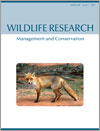Context. Long-term studies of large, vertebrate mammals using capture–recapture data are scarce, even though long-term ecological studies are requisite to understanding quantitative genetics and evolutionary processes that can be applied as part of management programs.
Aims. Objectives were to (1) partition components of variation in body mass to understand the differential effects of environmental variation on the sexes during ontogeny, to better prescribe habitat-improvement projects, and (2) estimate repeatability to assess potential for selection on body mass.
Methods. We used a 23-year dataset (1983–2005) of capture–recapture records of wild white-tailed deer (Odocoileus virginianus) to estimate components of variance and repeatability of body mass. We used an animal-model approach that employed the use of general linear mixed models and restricted maximum likelihood to adjust for the effects of age (i.e. fixed effect), and to partition the total phenotypic variance into among-individual (i.e. the deer), permanent environmental (i.e. year of birth) and temporary environmental (i.e. year of measurement and residual) effects (all modelled as random effects).
Key results. We found that body mass increased with age in both sexes, repeatability of body mass was 0.595 for females and 0.716 for males, and among-individual variation was more influential on body mass than were permanent and temporary environmental effects combined. Year of birth was more important in males than females, but changed during the course of ontogeny for both sexes. Year of measurement did not influence post-rut body mass in males, but did contribute to variation in body mass of females.
Conclusions. These long-term data offer insights into the sources of variation that influence body mass of deer, which can be used to understand how environmental sources of variation influence phenotypic traits, and for developing management plans and making selection decisions.
Implications. Knowledge of repeatability (as an upper limit to heritability) can be used to make management decisions related to selection, culling and breeding, whereas understanding environmental effects can lead to better management recommendations (e.g. habitat-improvement projects).





